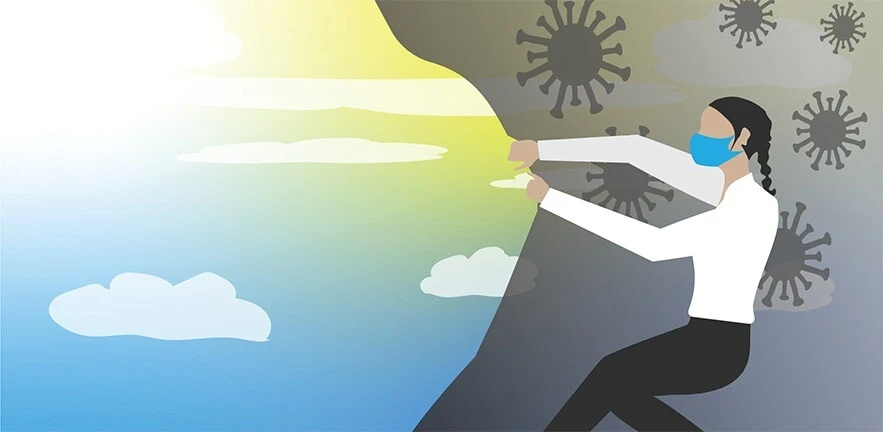Re-learning how to manage risk can be a template for the future governance of crises, say academics from the Centre for Business Research at Cambridge Judge Business School.
This article, which originally appeared on the website of the University of Cambridge, is by Simon Deakin, Professor in the Faculty of Law and Director of the Centre for Business Research (CBR), and Dr Gaofeng Meng, Research Fellow of the CBR specialising in property law, with particular reference to Chinese law.
As the pandemic crisis has played out across the world, different types of government have taken different approaches to controlling the spread of virus and supporting citizens – with different outcomes. Can we start to draw conclusions on how best to govern future catastrophic risks?

In the 12 months since Wuhan Municipal Health Commission reported a cluster of cases of pneumonia from which a novel coronavirus was eventually identified, global efforts to contain it have gone from understanding SARS-CoV-2 and the disease it generates, to studying human behaviour and how the virus is transmitted.
But there are some questions that virology and epidemiology alone cannot answer, such as why COVID-19 (Coronavirus) infection and mortality rates differ so widely across countries.
We now know that the impacts of COVID-19 are highly skewed not just by personal factors such as age and underlying health but by social factors such as occupation, income and access to basic goods including housing. And we’ve also seen a wide divergence in states’ reactions to the virus and in the control and support measures they have taken.
“Re-learning how to manage risk can be a template for the future governance of anthropogenic crises, of which COVID-19 is likely just the harbinger.”
Understanding the role played by institutions, both public and private, in framing the way that risks of the kind posed by COVID-19 are managed has been comparatively neglected. Our recently published research on the governance of COVID-19 set out to fill this gap as an essential step for the future control of pandemics and other anthropogenic risks.
Lessons from Wuhan
We are still in the early stages of a pandemic episode whose eventual trajectory cannot be straightforwardly predicted. However, it is already possible to see striking differences in countries’ responses to it and to observe some trends.
States differ in the aims they have adopted in managing the disease, on a spectrum ranging from repression to mitigation and accommodation. They also differ in the means used to implement these aims, from direct enforcement through regulatory instructions and criminal sanctions, to more indirect encouragement and persuasion.
It is not yet possible to state with any certainty how differences in these responses may be related to their differing degrees of success in countering the effects of the virus but we can nonetheless identify some states that have experienced very low numbers of fatalities. The list is short, but contains countries from all continents.
Several of these countries are in East Asia, including South Korea and Taiwan, where experience of the SARS 1 epidemic in 2003 might explain their rapid efforts to control SARS-CoV-2. The low numbers of cases in Uruguay, Denmark, Norway, Finland, Australia and New Zealand might in turn relate to their being democracies with relatively egalitarian distributions of income and wealth.
The case of China is complex. It does not claim to be a liberal democracy, and its recent economic growth, while lifting hundreds of millions out of poverty, has created new inequalities.
From the perspective of the West, the elimination of the virus in the city of Wuhan, where it was first identified, is generally taken to have been achieved through draconian interventions and coercion of a kind that could not be replicated elsewhere.
A closer look at Wuhan of the kind we undertake in our paper “The Governance of COVID-19: Anthropogenic Risk, Evolutionary Learning, and the Future of the Social State” suggests that coercion is not the whole story. Support measures were also critical.
According to the White Paper published by the State Council of the People’s Republic of China in June 2020, these measures included the dispatch of 346 medical teams composed of 42,600 medical workers and 965 public health workers from across the country to Hubei Province.
During the peak of the testing carried out in Wuhan in February 2020, there were over 1,800 teams of epidemiologists in the city tracing tens of thousands of contacts. These actions were made possible by a concerted central government response, coupled with fiscal transfers and direct aid from provinces less exposed to the virus.
Of course, the White Paper is the Chinese government’s account of its own performance, and so should be not be equated with an independent record of what happened. There is, however, already a significant body of research reporting on details of the Chinese response, including the role played by community-based contact tracing. Several eye witness accounts have also appeared. These point to the widespread presence of volunteers from across the country in Wuhan during the critical weeks of the crisis.
There is no dispute that Wuhan had returned to something like normality by the summer of 2020.
Lessons from history
What happened in Wuhan, we suggest, has to some extent been misunderstood in the West.
Early on, in March 2020, an article in Science characterised the measures taken there as ‘abhorrent in a free and just society’. However, it should be remembered that quarantines and cordons sanitaires have a long history in the West.
Chinese commentators writing in the spring of 2020 saw in Wuhan a scaling up of the experience of the English village of Eyam, which engaged in a form of collective self-isolation in response to the arrival of the plague from London in 1665. The response of the villagers of Eyam may not have been entirely altruistic; it was common at this time for areas affected by the plague to be cordoned off by surrounding towns in return for the provision of supplies.
Control was therefore combined with support. James I’s Plague Act of 1604 was aimed at the ‘relief and ordering of persons infested with the plague’ (our emphasis). There are many other European examples, up to and including the ‘Leicester model’ of disease control, dating from the 1890s, which the World Health Organization (WHO) later used as its template for the worldwide eradication of smallpox.
We think that the wrong lesson to learn from Wuhan is that states must choose between doing nothing and allowing the virus to run its course, and coercive controls of the kind that suspend normal civil and commercial freedoms.
Where should we go from here?
Making systematic cross-national comparisons is fraught with difficulties that make the identification of causal links between institutional interventions and health outcomes a problematic undertaking. However, some emerging trends can be identified that could help future governance of the risks we face in terms of allocating resources, making decisions and implementing policies.
We make two suggestions of a general nature for thinking about the overall goals of governance:
- ‘Normalising’ COVID-19 by treating it as a natural event that will eventually recede without the need for concerted action will not work very well for any state attempting it
This policy would make the disease endemic: as with smallpox and cholera in the relatively recent past. COVID-19 would become stable and in a sense manageable, but still a serious health risk to certain parts of the population, and a continuing drain on scarce resources. - Policies that treat the virus and society alike as self-adjusting systems will not in practice lead to the hoped-for minimisation of state control
In the absence of a concerted public health response based on the logic of ‘find, test, trace, isolate and support’, periodic waves of the virus will be met by repeated lockdowns. These are likely to be accompanied by a renewed emphasis on the disciplining and control of the population.
To avoid those negative outcomes, we make the following specific suggestions:
- To retain the trust of the population and avoid future social costs, quarantines and travel restrictions should be proportionate and limited
China has at no point attempted a national ‘lockdown’ and the WHO does not recommend it. Suspending normal civil and commercial activity carries a social cost, including negative health effects, which may be long term and so less salient in policy terms, but potentially highly damaging. - Where they are adopted, control measures must be counterbalanced by support for households and communities
The UK’s Coronavirus Job Retention Scheme could be improved; our research shows that it supports businesses directly but household income only indirectly, and may not prevent mass redundancies going forward. - Support is also critical to ‘test and trace’
Countries in which the government meets subsistence and accommodation costs for households undergoing self-isolation have been more effective in driving down infection rates. - Getting testing, tracing and support right will help avert serial lockdowns, and is best done at community level
The emerging evidence is that test and trace systems work best when delivered by local public health teams. Street-level community engagement is good at engendering trust; surveillance-using apps and big data, less so. Outsourcing to the private sector creates new layers of bureaucracy and unnecessary contracting costs.
What’s next?
While the genetic mutation that produced the SARS-CoV-2 virus may have been a random occurrence, the pandemic that ensued was not.
On the contrary, epidemics and pandemics have a recurring pattern throughout history that makes them statistically predictable. They are the combined effect of patterns in biological and human evolution. They are ‘anthropogenic’ events in the sense that they are triggered by the interaction of human activity with the wider environment, and the feedback effects brought about by commercial exploitation of natural resources, the spread of trade, movements of populations and widening of social inequalities.
Finding an alternative path for governing should begin with rethinking currently influential accounts of governance and governmentality.
Essential to this process is remembering that poverty and disease are neither natural phenomena nor the result of individual choices, but the consequences of human institutions, and that as such they have to be addressed institutionally. Re-learning how to manage risk through the welfare or social state can be a template for the future governance of anthropogenic crises, of which COVID-19 is likely just the harbinger.
This article originally appeared on the University of Cambridge website.


